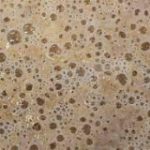All Rise
 Making hot cross buns at the weekend, my thoughts turned to yeast. Why, I pondered apart from breads and enriched breads, (traditional buns, croissants and the like) is yeast used so little these days? I then researched it a little. I found hundreds of recipes using the stuff. Back to the drawing board.
Making hot cross buns at the weekend, my thoughts turned to yeast. Why, I pondered apart from breads and enriched breads, (traditional buns, croissants and the like) is yeast used so little these days? I then researched it a little. I found hundreds of recipes using the stuff. Back to the drawing board.
So instead I went back in time about 50 years. I was treasurer of the Edinburgh Students' Yorkshire Society. (It's a long story.) We were holding a cake sale to raise money for charity. With pride and anticipation, I found a recipe and bought shiny new cake tins. Mysteriously I created not two lovely light fluffy sponges, but two solid chocolate flavoured discuses (disci?). As you will have guessed, I had no notion that there were different types of flour, and that the self raising stuff contains something called baking powder.
 Recipes from before the middle of the 19th century won't mention it, because it hadn't been invented. Many may know the name of Alfred Bird, inventor of Bird's custard, still available to this day. Bird's wife was allergic to eggs, so he used his skills as a chemist to invent an egg free custard powder in 1837. Mrs Bird was also allergic to yeast so, six years later, he came up with baking powder. Not, as it happens the version we use today. For that, we have to thank American inventor, Eben Norton Horsford.
Recipes from before the middle of the 19th century won't mention it, because it hadn't been invented. Many may know the name of Alfred Bird, inventor of Bird's custard, still available to this day. Bird's wife was allergic to eggs, so he used his skills as a chemist to invent an egg free custard powder in 1837. Mrs Bird was also allergic to yeast so, six years later, he came up with baking powder. Not, as it happens the version we use today. For that, we have to thank American inventor, Eben Norton Horsford.
Bird's version was of limited value as it was what is now known as single-acting. By that is meant that it gave off carbon dioxide when dampened, and that was that. Horton's double-acting version does the same as Bird's, but then gives off more when heated. It's much faster acting than yeast. There is no fermentation involved. The distinct flavour of fermentation is fine in your sourdough, but less desirable in your Victoria sponge. You will find baking powder in most domestic kitchens, but I suspect there will be many where yeast never makes an appearance.
 So what is baking powder? In essence it's a mixture of bicarbonate of soda and a mild acid, loosely based on tartaric acid. Like fast action yeast, it's inert until treated with liquid and heat. That will come as a surprise to no one in Ireland, nor anyone who has made soda bread. No yeast involved, so you don't get gas bubbles trapped in the gluten. Yet soda bread does rise a bit. How? It's actually the same principle at work as in baking powder. The acidity of the buttermilk reacts with the alkaline baking soda to do the job for you.
So what is baking powder? In essence it's a mixture of bicarbonate of soda and a mild acid, loosely based on tartaric acid. Like fast action yeast, it's inert until treated with liquid and heat. That will come as a surprise to no one in Ireland, nor anyone who has made soda bread. No yeast involved, so you don't get gas bubbles trapped in the gluten. Yet soda bread does rise a bit. How? It's actually the same principle at work as in baking powder. The acidity of the buttermilk reacts with the alkaline baking soda to do the job for you.
Yeast itself is a fascinating subject. It would take people far more knowledgeable than I to write a treatise on it. I can tell you that there are at least 1500 known types. Uses for it include face cream, slug control and compost accelerator.
I shall pause now, having just remembered that in the excitement of cooking yesterday's Easter feast, I forgot to feed Tony, my sourdough starter. Happy baking.